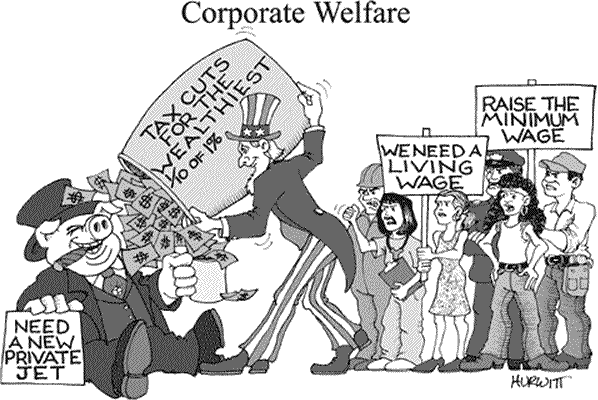
(Cartoon image is by Mark Hurwitt at
hurwittgraphics.com.)
Donald Trump (and congressional Republicans) are trying to sell the American public on the idea of giving corporations a huge tax cut. They claim that American corporations pay the highest taxes in the developed world, that tax cuts would make them more competitive, and that this would benefit workers (creating new jobs and higher wages). None of that is true.
Here is the truth from Josh Bivins and Hunter Blair at the
Economic Policy Institute. I include only part of their excellent article, but recommend you read the whole article.
Do U.S. corporations pay significantly more in income taxes than companies in our peer countries?
No. American corporations are clearly not heavily taxed relative to international norms.
While the statutory U.S. corporate tax rate of 35 percent is on the high end internationally, corporations don’t actually pay anywhere near that rate on average. Using loopholes to avoid paying their full tax bills, corporations pay aneffective tax rate of between 12.5 percent and 21.2 percent One of the key loopholes is deferral—which allows U.S. firms to pay zero taxes on profits booked overseas (often through clever accounting practices) unless and until those profits are “repatriated” (returned) to owners in the United States.
Measured as a share of total GDP, U.S. corporations pay significantly less than their international peers. In 2015, the revenue raised through U.S. corporate taxes equaled 2.2 percent of GDP. On average, other member countries of the Organization for Economic Cooperation and Development (OECD) raised 2.9 percent of GDP through corporate taxes.
Would cutting corporate tax rates boost American jobs?
No. Corporate tax cuts are about the worst fiscal tool we have for boosting job growth.
In an economy constrained by too-slow spending (or a lack of aggregate demand, in economists’ jargon), tax cuts can in theory boost demand by raising (post-tax) incomes and inducing households to spend more. But the bulk of corporate tax cuts would benefit the richest Americans, and these households are far less likely to spend an additional dollar for every dollar in tax cuts than low- or middle-income households. To put it simply, spending of rich households is not constrained by too-low incomes, so giving them more income does little to induce more spending.
If Congress wants to spur demand and create jobs with fiscal policy changes, it should either target tax cuts at low- and middle-income families, or boost spending directly. This recommendation is clearly borne out by all serious economic evidence: in a ranking of fiscal policy changes based on bang for the buck—how many jobs they create—corporate rate cuts are near the bottom of the list.
Would cutting corporate tax rates boost American investment or wages?
No. Companies are not investing in the things that could boost wages by making workers more productive (plants and equipment, technology, research) because of insufficient demand, not because they don’t have the profits to invest or because they face high interest rates.
If the economy’s growth is not constrained by too-slow spending, then there is a theoretical case that corporate rate cuts could boost growth by encouraging investments that increase the economy’s productive capacity (“supply side” effects). However, today’s real-world data indicate strongly that this theoretical case will fail.
The argument that corporate rate cuts would boost investment in plants and equipment depends on a long chain of influences. Here is how it would work theoretically. First, by boosting the post-tax return to owning capital like stocks and bonds, the rate cuts induce households to save more. Next, this increased supply of savings drives down economy-wide interest rates. This fall in interest rates then induces firms to borrow more to invest in plants and equipment. The new plant and equipment investments give workers better tools to do their jobs, boosting productivity and thus (as many assume) mechanically boosting wages.
But nearly every link in this chain fails when faced with today’s real-world data. For one thing, post-tax corporate profit rates remain historically elevated, down just a bit from the historical peaks they hit in recent years. Yet these higher rates have not been associated with rapid investment in plants and equipment in recent years. For another thing, we don’t currently have a situation in which deficient savings is leading to high interest rates and thus depressing investment. Corporate savings are high and interest rates remain extremely low relative to historical data. The combination of low interest rates and low investment with high profit rates signals extraordinarily strongly that the constraint on investment is sluggish demand, not insufficient savings. This means that policy changes that reduce spending (consumption) to boost savings are actually likely to slow growth, not boost it.
And there are even more fundamental problems with the logic of the “tax cuts will boost savings” link in the chain. While corporate rate cuts can boost household savings, they unambiguously reduce public savings by increasing the federal budget deficit. This makes their effect on total national savings (the relevant measure for influencing interest rates) a wash at best. So corporate rate cuts alone will not boost savings unless paired with spending cuts or other tax increases.
Finally, even if insufficient savings were the problem and somehow corporate tax cuts did boost plant and equipment investment and boost productivity, this still doesn’t guarantee that wages for the vast majority of American workers would rise. Wages for the vast majority of U.S. workers stopped rising in tandem with productivity decades ago. Workers are more valuable but companies aren’t paying them more. The disconnect between productivity growth and wage growth is the result of a set of intentional policy decisions that have eroded the bargaining power of workers. Cutting corporate tax rates is not the solution that will reverse this trend.
 (Cartoon image is by Mark Hurwitt at hurwittgraphics.com.)
(Cartoon image is by Mark Hurwitt at hurwittgraphics.com.)
